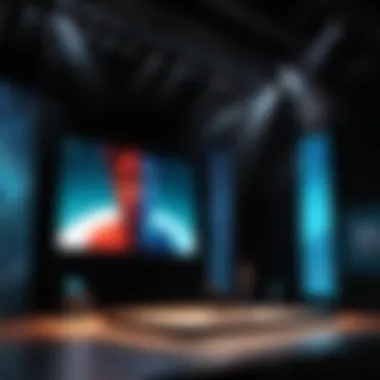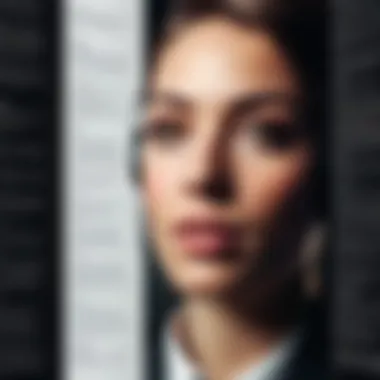Exploring Spoken Word Poetry: A Powerful Expression


Intro
Spoken word poetry stands at the crossroads of tradition and modernity, breathing new life into age-old forms of expression. Its roots can be traced back to ancient storytelling practices, where oral traditions played a crucial role in sharing culture, history, and personal experiences. This art form has evolved, adapting to contemporary society, shifting social dynamics, and the rapid technological advancements that shape the way we communicate today.
The essence of spoken word lies in its ability to convey emotion, challenge norms, and spark discussions that matter. From coffeehouse performances in the 1960s to thriving platforms on digital media today, spoken word poetry bridges the gap between the personal and the collective, serving as both a mirror and a voice for individuals grappling with their identity and societal issues.
In this exploration of spoken word poetry, we will dive into its origins, significant figures, performance tactics, and the vital role technology plays in its proliferation. By understanding its layers, we create a deeper connection with this vibrant medium that continues to resonate with audiences across the globe.
Understanding Spoken Word Poetry
Spoken word poetry is more than just a performance—it's a powerful medium for self-expression and societal critique. It taps into the raw emotions and experiences of individuals, allowing them to share their stories in a way that resonates deeply with audiences. Understanding this art form sets the stage for a broader appreciation of its cultural significance and its role in contemporary dialogue.
Definition and Characteristics
Spoken word poetry is characterized by its emphasis on vocal delivery and performance. Unlike traditional poetry that might reside solely on the page, spoken word combines words with rhythm, tone, and body language to create an immersive experience. It often features:
- Emotional Intensity: It's personal and intense, focusing on the poet's feelings and thoughts.
- Rhythmic Patterns: Many spoken word pieces incorporate musicality, mirroring the beats found in music genres like hip-hop or jazz.
- Societal Themes: Various topics are explored, from personal struggles to community issues, making it relevant and relatable.
One intriguing aspect is its spontaneous nature. Poets may draw from current events or personal experiences to create pieces in real-time, adding an element of freshness that captivates listeners. The blend of storytelling and performance also fosters a community vibe, as audiences often engage with the content, responding with applause or laughter.
Significance in Art and Literature
The role of spoken word poetry in art and literature is profound. It acts as a mirror, reflecting cultural dynamics and personal narratives. Here are a few important points regarding its significance:
- Cultural Reflection: Many spoken word poets explore their cultural identities, which permeates their work. It holds a mirror to societal issues, urging audiences to examine their contexts critically.
- Accessible Art Form: It democratizes poetry, making it accessible to those who might not engage with written forms. By prioritizing performance, it invites a diverse range of voices into the literary conversation.
- Transformational Impact: Through performances, poets can inspire social movements. A well-delivered poem can stir emotions, motivate action, and deepen understanding of complex issues.
"Art is not freedom from discipline, but disciplined freedom."
— John F. Kennedy
The richness of spoken word poetry demonstrates how it transcends the written form, creating an impactful platform where words become an instrument of change. It challenges norms and expectations, setting a precedent for how poetry can influence art and culture.
Historical Context of Spoken Word Poetry
Understanding the historical context of spoken word poetry is pivotal for grasping its significance as a contemporary art form. This genre emerged not merely from a vacuum but rather as a symphony played on the strings of cultural evolution. By examining its roots, we can appreciate how it embodies the voices of the past while echoing through modern platforms. A closer look at its origins and development sheds light on the myriad ways spoken word has woven itself into the fabric of artistic expression today.
Roots in Oral Tradition
Spoken word poetry has deep roots in the oral traditions that predate the written word. Long before Shakespeare penned his verses or even before Homer spun his tales, communities relied on storytelling to convey their experiences, values, and beliefs. Stories were shared around fires, in marketplaces, and during ceremonies. These narratives played a crucial role in teaching lessons, preserving history, and fostering cultural identity.
An example can be drawn from the griots of West Africa, who acted as not just historians but custodians of culture. Their performances were rich with rhythm and rhyme, and these elements remain integral to spoken word today. The act of reciting poetry aloud brings a certain immediacy and personal connection that is sometimes lost in written text.
In many cultures, this form was also deeply intertwined with communal rituals, where the act of speaking became a communal experience. Listeners were more than mere bystanders; they were a part of the fabric of the narrative itself, influencing its tone and emotion through their responses. This interaction is a hallmark of spoken word poetry and highlights its significance in fostering community.
Evolution Through the 20th Century
The 20th century marked a significant turning point for spoken word poetry. As societal dynamics shifted, so too did the medium's styles and themes. The Harlem Renaissance in the 1920s stands out as a vibrant explosion of creativity, where poets like Langston Hughes used their voices to express the struggles and aspirations of African Americans. This era laid the groundwork for spoken word to simultaneously challenge and uplift cultural narratives.
Furthermore, the rise of performance poetry in urban settings brought a blend of musicality and storytelling to the forefront. Events like slams and open mics transformed poetry into a competitive art form, allowing poets to find their voices and reach wider audiences. Notably, organizations like the Poetry Foundation have actively supported this evolution, giving poets a platform to share their work.
By the end of the century, spoken word poetry had not only flourished in literary circles but also infiltrated music genres like hip-hop. Artists began incorporating poetic elements into their lyrics, blurring the lines between different forms of artistic expression. This trend opened the door for spoken word to be seen as a legitimate and potent medium for social commentary and personal expression, leading to the vibrant scene we see today.
"Spoken word serves as a bridge between tradition and modernity, reflecting societal changes while honoring its rich history."
In summary, the historical context of spoken word poetry is crucial for understanding its evolution and continuing relevance. It serves as a living chronicle of human experience, an art form that draws on the past as it boldly steps into the present.
Key Influences on the Genre


Understanding the influences that shape spoken word poetry is essential for grasping its current relevance and nuances. This art form, which deftly intertwines spoken language with performance, has roots that dig deep into various cultural currents and artistic movements. The intermingling between these frames of reference not only enriches the genre but also offers poets a unique platform to amplify their voices on pressing issues.
Cultural Movements and Social Issues
Spoken word poetry is inherently tied to cultural movements and social issues, acting as both a mirror and a megaphone. From the Civil Rights Movement in the United States to movements supporting LGBTQ+ rights, these events have provided fertile ground for spoken word poets to articulate experiences, frustrations, and aspirations.
In the tumultuous landscape of societal change, artists often find their mic as a means to protest and provoke thought. They craft narratives that resonate with the lived experiences of various communities. The personal is profoundly political; a poem about one’s personal struggles can serve to highlight systemic inequalities and injustices faced by many. Through the power of storytelling, poets like Audre Lorde and Gil Scott-Heron have showcased how art can drive social change and engage audiences in meaningful conversations about topics that matter.
The ongoing dialogues about race, gender, and identity are vital threads that weave through spoken word performances. These discussions aren’t just limited to the stage but extend into public spaces, online platforms, and classrooms. By aligning their work with such movements, poets create an enduring impact that drives awareness and fosters community solidarity.
"Poetry is not a luxury. It is a vital necessity of our existence." - Audre Lorde
Impact of Hip-Hop and Music
Hip-hop culture has been a game-changer for spoken word poetry, infusing it with rhythmic flair and a direct conversational style. This influence can be traced back to the early days of hip hop, where spoken word was an integral part of the art form. Rhyme schemes, rhythms, and delivery techniques from rap music have been successfully transposed into spoken word performances.
Poets often mix the two forms, utilizing beats to enhance their spoken narratives. This blend not only captivates the audience but also adds another layer to the emotional experience of the piece. Renowned poets like Saul Williams and Andrea Gibson have drawn from hip-hop's lyrical cadence, incorporating it into their performances to evoke strong reactions and encourage listeners to engage with the content on a deeper level.
The crossover appeal of hip-hop also aids in reaching broader audiences. Regional styles and identities within hip-hop often draw attention to local issues, making spoken word poetry an accessible entry point into complex societal problems. Young people, in particular, find the meld of music and poetry appealing, drawing them into poetical spaces they might not otherwise explore. By honoring hip-hop’s influence, spoken word poetry nurtures a collaborative spirit that breaks down traditional barriers, inviting diverse voices to converge in shared spaces for expression.
In essence, the key influences on spoken word poetry are shaped by its ability to speak to cultural movements and draw from musical styles. This intricate interplay not only enhances the art form but also invites audiences to witness the broader narratives surrounding community and identity.
Elements of Performance
The enchantment of spoken word poetry lies not just in the words themselves but in how those words are delivered. Truly, the elements of performance play a pivotal role in transforming a poem from mere text into an immersive experience that resonates with an audience. In this realm, delivery becomes as crucial as content, crafting a rich tapestry of expression that captivates listeners and invites them into the performance.
Rhythm and Meter in Delivery
Rhythm is the heartbeat of spoken word. Much like a drummer setting the pace for a band, the poet's control over rhythm and meter shapes the way audiences receive each line. A poem can invoke varied emotions simply through its pace. For instance, a fast-paced delivery filled with urgency can stir feelings of excitement or anxiety, while a slower, more deliberate cadence invites reflection and introspection.
When poets play with meter, they can create unexpected moments that catch listeners off guard, pushing them to engage with the content on a deeper level. The interplay between stressed and unstressed syllables is like a dance, where each movement adds to the overall impact. Furthermore, incorporating literary devices such as alliteration and assonance amplifies this rhythm, creating a sonic landscape that enhances the poem's meaning.
Body Language and Presence
Presence is another cornerstone of performance. A poet's body language can convey emotions that words alone may not fully capture. Gestures, facial expressions, and posture all contribute to the storytelling aspect of spoken word. Imagine a poet passionately slamming their hand on a table at a crucial line—this simple gesture amplifies the intensity of their words, transforming an otherwise quiet moment into a powerful statement.
Maintaining eye contact can forge a connection with the audience, inviting them to share in the experience rather than merely observe. A poet's physicality can speak volumes; the way they navigate the stage or space can create intimacy or distance, depending on the intention behind their movements. This dynamic interaction between the poet and the audience is pivotal, as it breathes life into the words and sustains engagement throughout the performance.
Ultimately, both rhythm and body language serve as vehicles for the poet's expression. The unique marriage of these elements captures not just the meaning behind the words, but the essence of the human experience. That’s what turns spoken word poetry from a solitary act to a communal experience, a dance of hearts and minds exchanging stories.
"The performance of spoken word poetry transcends the written word, transforming it into something visceral—an art that can be felt as much as it can be heard."
As audiences become more attuned to these elements, their appreciation for spoken word poetry deepens, recognizing the skillful nuances that elevate a poem from good to unforgettable.
Themes and Topics in Spoken Word Poetry
Spoken word poetry stands as a powerful fountain of expression, blending personal narratives and broader societal issues into an art form. It provides an essential platform where poets can explore themes of identity, social justice, and mental health, among others. These themes not only resonate with audiences but also push forth critical conversations that often go unheard. Understanding these topics is essential for grasping the profound impact this art form can have on both the speaker and listener.
Personal Experience and Identity
Delving into personal experience is at the heart of spoken word poetry. Poets often share their unique stories, painting vivid images of their lives and identities. This intimate portrayal creates a connection with audiences who may find parts of their own experiences mirrored in the poet’s words. The vulnerability displayed in these pieces allows listeners to not only empathize but also reflect on their own journeys.
For instance, a spoken word piece centered around the struggles of navigating cultural identities can attract an audience that feels seen and heard. Elements such as storytelling and anecdotes play pivotal roles in enabling this connection. When poets share their narratives, they invite listeners to engage, ponder, and ultimately feel part of a larger dialogue.
Political and Social Commentary


Spoken word poetry is a potent vehicle for political and social commentary. Poets use the stage to address injustices, inequalities, and movements that demand attention. These pieces often reflect contemporary societal issues such as racism, gender inequality, or environmental crises. By weaving personal experiences into these topics, poets create a tapestry of collective consciousness that encourages listeners to question, analyze, and reflect.
Consider how a poem touching on climate change, infused with personal stories or local realities, not only informs but stirs emotions. It can spark passionate discussions and mobilize communities towards action. Here, the beauty of spoken word thrives, as it transcends mere entertainment and becomes a rallying cry for change.
Exploring Mental Health and Emotional Struggles
At a time when mental health discussions are more crucial than ever, spoken word poetry provides an open space for exploring these often-taboo subjects. Poets dive into their personal battles with anxiety, depression, and other mental health challenges, using their art as both a form of catharsis and a means of understanding.
This theme can significantly impact listeners who may be experiencing similar struggles. A poem that discusses the sensation of feeling lost or avenues of recovery can resonate deeply, fostering feelings of not being alone.
"Your words can be a lifeline. Every story shared is a moment of connection, of healing."
Notable Spoken Word Poets
Spoken word poetry is fundamentally shaped by the voices and experiences of its practitioners. Highlighting the contributions of notable spoken word poets not only recognizes their artistry but also illuminates the evolution of this form of expression. These poets, with their diverse backgrounds and varying styles, often address shared human experiences, cultural conflicts, and societal injustices, making them pivotal in both cultural movements and artistic dialogues. The significance of these individuals can’t be overstated, as they act as both historians and activists, weaving their personal narratives into the broader tapestry of spoken word poetry, providing depth and resonance.
Modern Influencers and Their Contributions
In today's landscape, the role of modern spoken word influencers has gained momentum, shaping the direction of this genre in sonorous waves. Take for instance Sarah Kay, a name that resonates widely. Her performances are a blend of vulnerability and strength, often touching on the themes of identity, love, and belonging. Another significant figure is Phil Kaye, known for his storytelling prowess and ability to capture complex emotions in a mere few minutes. Their work is heavy with meaning and often accessible via platforms like YouTube, which has transformed the way audiences engage with poetry.
Beyond mere performance, these poets also contribute through workshops and educational programs, making spoken word more accessible, especially among youth. They help carve out a space in classrooms for expression and creativity. This generation of poets champions the use of digital media, breaking geographical boundaries and allowing their message to reach global ears, a factor that is vital for the growth of spoken word poetry as an influential art form today.
Historical Figures in the Field
When we delve into the past, figures like Gwendolyn Brooks and Amiri Baraka stand out. Brooks, as the first African American to win the Pulitzer Prize for poetry, used her platform to amplify the voices of her community, merging spoken word with social activism. Baraka, on the other hand, played a crucial role in the Black Arts Movement, pushing boundaries and using his poetry to provoke thought and inspire change. Their legacies continue to inspire modern poets, illustrating that the roots of spoken word poetry are not just rich but also revolutionary.
"Poetry is a political act because it involves telling the truth." - Alberto Ríos
While the landscape may be dotted with various styles and thematic preoccupations, it is the historic figures that provide a foundational backdrop for understanding contemporary spoken word. Their work underlines the political and cultural dimensions inherent in spoken word poetry, showcasing it as not merely an artistic endeavor but as a vital tool for change and reevaluation of societal norms.
In sum, both modern and historical figures contribute incredibly to the spoken word tradition, enriching it with layers of history, emotion, and thought-provoking themes.
Spoken Word Poetry in Digital Media
In today’s rapidly evolving landscape of technology and communication, the intersection of spoken word poetry and digital media has created a unique platform for poets. As artists, they can reach a broad audience quickly, breaking down the barriers traditionally found in the art form. The emergence of social media, video platforms, and other online channels has given spoken word poetry not just a voice, but also a global stage.
Platforms and Accessibility
Digital platforms play a vital role in the dissemination and accessibility of spoken word poetry. Websites and applications like YouTube, Instagram, and TikTok have transformed the way poetry is performed and perceived. For poets, these platforms allow for instant upload and sharing, enabling their work to be viewed by millions.
Notably, accessibility increases for various audiences, especially marginalized voices who might not have had the opportunity to perform in conventional venues. By swiftly uploading their pieces online, poets create a digital footprint, allowing their art to be experienced beyond physical limitations. This digital reach fosters a sense of community among poets and their audiences, as feedback and interaction can occur in real time.
Another significant benefit is the ability to create multimedia presentations. Poets can blend their performance with visual elements, background music, and even animation, making their pieces more engaging. This multimedia aspect enriches the poetry experience and attracts a wider audience, keeping them captivated longer.
Viral Trends and Challenges
However, with great opportunities come several challenges. One significant issue is the potential for spoken word poetry to become a trend rather than an art form. The viral nature of the internet can sometimes overshadow the deeper meanings and messages of the poetry itself, prioritizing sensationalism over substance. In essence, a piece might go viral for its shock value or dramatic flair, while its intricate craftsmanship goes unnoticed.
Moreover, competition for attention is fierce in the digital space. With countless talented poets sharing their work, standing out becomes a necessity but can also feel daunting. Poets may feel pressured to conform to certain trends or popular aesthetics, which could dilute their authentic voice.
Yet, this challenge can also be viewed as an opportunity for growth. To thrive in the digital arena, spoken word poets can continuously innovate, pushing the boundaries of how their craft interacts with technology. This evolution may lead to interesting styles or movements that redefine the genre itself.
As spoken word poetry morphs in conjunction with digital platforms, artists must remain mindful of their messages while adapting to new forms of engagement. The adaptability of this art form is essential, ensuring it continues to resonate in an ever-changing world while serving its fundamental purpose: communication and expression.
"The beauty of spoken word poetry in digital media lies in its immediacy and reach. It is not only about the words spoken but the conversation sparked."


In concluding this section, it’s clear that spoken word poetry has found fertile ground in digital media. Creators must navigate the evolving landscape deftly while staying true to the essence of their art.
The Role of Competitions and Festivals
Competitions and festivals serve as the lifeblood of spoken word poetry. These events create a dynamic space where poets showcase their craft, engage with audiences, and build community. They are not merely competitions that gauge talent; they act as platforms for voicing diverse narratives, fostering connections, and providing validation to artists and their stories.
National and International Events
Numerous national and international events play a pivotal role in shaping the landscape of spoken word poetry. Some of the most renowned include the National Poetry Slam, held annually in the United States, and the World Poetry Slam, which brings poets from around the globe into a single arena.
Participating in these events can be exhilarating yet daunting. Poets prepare for weeks, honing their pieces to perfection, while the atmosphere is often electric with creativity and competition. Audiences become part of the experience, cheering and reacting in real-time. The importance of this interaction cannot be overstated. It transforms the poet's performance into a communal experience, where messages reverberate through the crowd.
Being recognized at such events can catapult a spoken word artist's career. Winning or even making it to finals can bring considerable attention from literary circles, publishers, and media, leading to greater visibility both online and offline.
Community Building Through Performance
Competitions and festivals are fundamental to cultivating a sense of community within the spoken word scene. Poets often come together not only to compete but also to share experiences, techniques, and insights. They form connections that can lead to collaborations, mentorships, and lifelong friendships.
- Networking Opportunities: These gatherings offer poets a chance to network beyond their local scenes. Often, poets can meet industry professionals who can help further their careers.
- Workshops and Panels: Many festivals include workshops and panels where seasoned poets share their wisdom. This contributes to the continuous growth of artists and invigorates the community.
- Inclusivity and Diversity: Events tend to highlight underrepresented voices, giving them a platform that may be lacking in traditional literary spaces. This focus enhances cultural dialogue and enriches the art form, making it more inclusive.
In essence, the role of competitions and festivals is multifaceted. They are not just about winning or losing; they are about forging connections, sharing art, and celebrating the beauty of spoken word.
"Competitions and festivals elevate spoken word poetry by creating spaces where voices are amplified and stories are born."
Whether at local venues or grand stages, these events resonate deeply, leaving lasting impressions on both performers and audiences, making them integral to the continued evolution of spoken word poetry.
Educational Implications of Spoken Word Poetry
The role of spoken word poetry in education serves as a bridge connecting traditional literary skills with contemporary modes of expression. This unique form of storytelling not only enhances literacy but also fosters an environment of empathy and understanding among students. Integrating spoken word poetry into the educational curriculum is essential for those looking to equip the next generation with the skills they need to articulate their thoughts and feelings effectively.
Integrating Poetry into Curriculum
Incorporating spoken word poetry into academic programs allows for a more relatable approach to literature. For instance, teachers could introduce poetry units that engage students in both reading and performance. This could include:
- Workshops: Conduct sessions where students learn the basics of writing spoken word pieces while practicing their delivery. This hands-on experience bridges the gap between theory and practice.
- Collaboration: Encourage students to work together, using peer feedback to refine their poems. Teamwork is crucial, as it simulates real-world artistic partnerships.
- Showcase Events: Schools might organize open mic nights or poetry slams, giving students an opportunity to present their work in front of an audience. This fosters not only confidence but also a sense of belonging within the artistic community.
Such integration can be enhanced by utilizing digital platforms. Virtual classrooms allow for easily collaboration, while online forums like Reddit can serve as spaces where students share their work and gain constructive criticism from others.
Benefits for Creative Expression and Communication
Embracing spoken word poetry in educational settings has numerous advantages:
- Enhanced Communication Skills: Students learn to express their thoughts articulately, improving both verbal and written communication.
- Boosts Creativity: The free-form nature of spoken word encourages students to experiment with language, structure, and rhythm.
- Cultural Awareness: As spoken word often reflects diverse experiences and backgrounds, students gain insight into different cultures and perspectives, fostering tolerance and understanding.
- Emotional Awareness: Writing and performing poetry can often serve as an outlet for personal experiences and struggles, helping students to better navigate their emotions.
"Spoken word poetry is more than just performance; it’s a profound form of communication that enables students to connect their personal narratives to broader societal issues, making learning deeply impactful."
Future Directions for Spoken Word Poetry
The trajectory of spoken word poetry remains an evolving narrative, deeply intertwined with sociocultural currents and technological shifts. As we look forward, it's essential to discern how this dynamic medium will adapt and thrive in an ever-changing landscape. The future of spoken word poetry is not just about preserving its roots but also about embracing innovation and fostering inclusivity.
Emerging Trends in Performance
One notable trend is the growing use of technology in live performances. Poets are increasingly incorporating multimedia elements—like projections, soundscapes, and even interactive digital components—into their work. This blending of forms creates a richer sensory experience for the audience and elevates the poetry beyond the spoken word alone. Think: a poet delivering a piece about urban decay while vibrant visuals of city life flash behind them. Audiences now expect a multi-dimensional experience; it's about engaging not only the ears but the eyes and hearts.
Furthermore, the rise of virtual events during the global pandemic has paved the way for more frequent online showcases. This shift to virtual open mics and digital competitions has expanded accessibility, allowing poets from various backgrounds and locations to share their voices. One of the beauties of this trend is that it democratizes performance—no longer are audiences limited to their local scenes. Now, a spoken word artist in Australia can connect with fans in Brazil or Italy, blurring geographical boundaries and fostering a global community of artists and readers alike.
Impact of Globalization on Local Scenes
The globalization of spoken word poetry intertwines with the performance trends we've discussed. Local poetic traditions are being influenced by global perspectives, as poets draw inspiration from different cultures and styles. For instance, an artist in Nigeria may blend elements of traditional African storytelling with contemporary spoken word techniques, remixing historical narratives into a fresh format. This cultural osmosis not only enriches the content but also opens channels for cross-cultural dialogue.
However, one must consider the balancing act that comes with globalization. While it encourages a rich exchange of ideas, there's also a risk of overshadowing local voices in favor of more mainstream or Western styles. To ensure that the essence of local scenes isn't lost, it's vital for communities to support their own poets and stories, showcasing them alongside emerging global influences.
In summary, as we peer into the future of spoken word poetry, we see a tapestry woven from both tradition and modernity. The conversation is ongoing, and as poets innovate, they also pay homage to their roots, creating a legacy that continues to resonate in diverse and meaningful ways.







